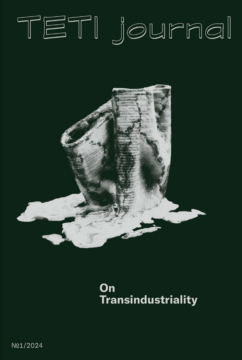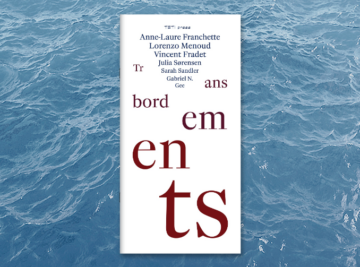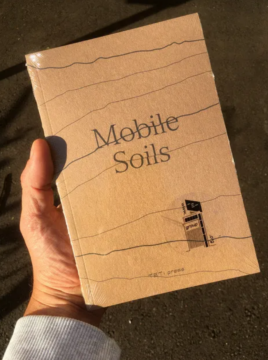by Rafaël Newman
 Last Saturday, November 2, 2024, at a collective atelier in Zurich’s Wiedikon neighborhood, I attended the launch of a new periodical. TETI Journal, available both online and in print form, is a publication presenting academic and artistic work in line with the aims of TETI Group, an “interdisciplinary research platform to investigate the changing materialities and imaginaries of our global societies.”
Last Saturday, November 2, 2024, at a collective atelier in Zurich’s Wiedikon neighborhood, I attended the launch of a new periodical. TETI Journal, available both online and in print form, is a publication presenting academic and artistic work in line with the aims of TETI Group, an “interdisciplinary research platform to investigate the changing materialities and imaginaries of our global societies.”
TETI Group, whose acronym stands for Textures and Experiences of Trans-Industriality, was founded in 2011 by the art historian Gabriel N. Gee, and is currently “animated” by Jose Caceres Mardones, Philippe Desarzens, Anne-Laure Franchette, Lori M. Gibbs, Stéphanie Gygax, Monica Ursina Jäger, Petra Koehle, Maria João Matos, Cora Piantoni, Bérénice Serra, Jan Van Oort, Caroline Wiedmer, and Gee himself. It includes TETI Press.

Gee coined the term trans-industriality in his 2008 doctoral dissertation, which examined the art scenes of industrialized northern England during the late 20th and early 21st centuries, in the wake of deindustrialization. As Gee writes in the introduction to the first issue of this new, spinoff vehicle, he was “intrigued by the social, but also cultural and political alternates that emerged to replace the former order, and by what appeared to be vivid connections to the industrial foundations of the modern age including the complex array of global entanglements associated with the dark side of modernity.” A complex array indeed, since for Gee, “the movement from industriality to post-industriality is not understood as being linear and synchronised, but rather, as multidirectional, ambiguous, leaning sideways and even backwards, in a constant metabolising process.”
The journal’s editorial board, meanwhile, which comprises Franchette, Gee, Gygax, and Wiedmer, “aims to emphasise the ongoing circulations between different industrial, technological, and cultural mutations, across interconnected historical periods,” and “seeks to reflect on the ongoing role played by material infrastructure in the age of new media and climate change, on the physical roots that still inform digital expansions and virtual networks, and on the survivals, revivals and haunting ghosts of past industriousness in the present and future.”
The initial call for contributions to the new journal had listed three disparate dimensions of such trans-industriality in its rhizomatic process of becoming:
The survival of technologies from one historical period to another (for example from telegraph to contemporary coded digital communications);
The cohabitation of technologies associated with different historical moments within a same period (for example the sail and steam ships in the 19th century, now revived with fair maritime trade initiatives);
The transfer of technologies from one industry to another (for example in the use of combustion engines, electric batteries, wind turbines, etc.).
Accordingly, the first issue of TETI Journal includes a heterogeneous range of texts. Cyrus Khalatbari, for example, addresses two very different ends of the PC production chain—optimization of hardware in Taiwan, and its recycling in Ghana—to assess “the material foundations of our digital environments,” while Loïc Rogard and Cédric Carles use examples of energy consumption to study the way bygone technological developments are revived in the service of future sustainability. Juliane Ahn reviews a vast pageant of surgical practices, from prehistory to cutting-edge robotic assistance, in a discussion of trans-materiality, trans-spatiality, and trans-consciousness; Mara Züst focuses on analogue photography’s ambiguous role in recording the real and creating its fictional double; and Paul Dolan visits the North-East of England, site of Gee’s own early research, where decommissioned coal mines are being refitted to produce geothermal energy, to explore “the reconfiguration of industrial landscapes,” thus “stressing the importance of relational attention to better negotiate our earthly environments.”
For my part, in this first issue of TETI Journal I propose the creation of yet another periodical, which would exploit a novel (but not entirely unheard-of) deployment of the cutting-edge, post-industrial, information-revolution technology known as blockchain or DLT (distributed ledger technology) to do something decidedly pre-industrial: disseminate poetry.
The piece grew out of work I had done in another context, showcased here and here, and leaves open a number of questions, apt for discussion in future venues (as for instance, potentially, in Common Speech, the as-yet-to-be-launched blockchain periodical proposed in TETI Journal)—including the trans-industrial implications, for the ancient art of poetry, of lyrical publication by means of decentralized technology.
 This is not the first time that work of mine has appeared under the aegis of TETI Group, which has two previous publications on its backlist: Transbordements, eds. Vincent Fradet, Franchette, Gee, Julia Sorensen, Lorenzo Menoud, and Sarah Sandler (TETI Press, 2023), and Mobile Soils, eds. Franchette, Jose Caceres Mardones, and Gee (TETI Press, 2021). Mobile Soils is a “collection of essays [which] reflects on the mobile ground beneath our feet, questioning the soil as both material and narrative in our interconnected territories.” My own contribution to that volume, co-authored with Caroline Wiedmer, reads the Swiss practice of regularly exhuming buried remains to make way for newly deceased inhabitants of cemeteries, and thus making superannuated headstones available for use in roadwork, as a means of inscribing private memory on the public body.
This is not the first time that work of mine has appeared under the aegis of TETI Group, which has two previous publications on its backlist: Transbordements, eds. Vincent Fradet, Franchette, Gee, Julia Sorensen, Lorenzo Menoud, and Sarah Sandler (TETI Press, 2023), and Mobile Soils, eds. Franchette, Jose Caceres Mardones, and Gee (TETI Press, 2021). Mobile Soils is a “collection of essays [which] reflects on the mobile ground beneath our feet, questioning the soil as both material and narrative in our interconnected territories.” My own contribution to that volume, co-authored with Caroline Wiedmer, reads the Swiss practice of regularly exhuming buried remains to make way for newly deceased inhabitants of cemeteries, and thus making superannuated headstones available for use in roadwork, as a means of inscribing private memory on the public body.
*
TETI Journal is grateful to Pro Helvetia and Franklin University, Switzerland, both of which supported its realization, and offers its heartfelt thanks to Lori Gibbs and Françoise Décugis for valuable feedback, Philippe Desarzens for his design, and Bérénice Serra for the the online platform.
